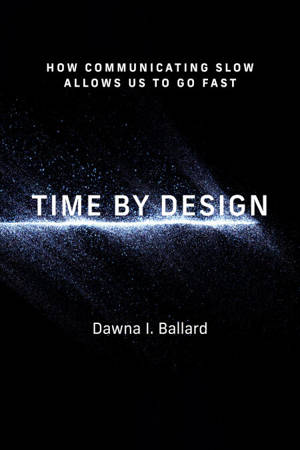
Bedankt voor het vertrouwen het afgelopen jaar! Om jou te bedanken bieden we GRATIS verzending (in België) aan op alles gedurende de hele maand januari.
- Afhalen na 1 uur in een winkel met voorraad
- In januari gratis thuislevering in België
- Ruim aanbod met 7 miljoen producten
Bedankt voor het vertrouwen het afgelopen jaar! Om jou te bedanken bieden we GRATIS verzending (in België) aan op alles gedurende de hele maand januari.
- Afhalen na 1 uur in een winkel met voorraad
- In januari gratis thuislevering in België
- Ruim aanbod met 7 miljoen producten
Zoeken
€ 39,42
+ 39 punten
Omschrijving
How effective individuals, teams, and organizations routinely communicate slow to go fast, and how time as a feature of human experience can actually be designed.
Speed in collective action, like teamwork or organizing, is never simply a time-based issue. While conventional theory relies on time-based interventions to achieve speed, this approach typically fails. In Time by Design, Dawna Ballard shows how speed is actually a function of the relationship between time and communication, or chronemics.
Ballard identifies two communication design logics—fast and slow—that reflect contrasting beliefs about how communication works to support urgent, time-sensitive work demands. Fast communication design logics are linear, short term in orientation, and treat time in interaction as transactional. Slow communication design logics are nonlinear and long term in orientation and treat time in interaction as transcendent. Given these distinct approaches, the book offers a practical toolkit that shows the reader how the two chronemic designs can be used in complementary fashion—and how effective teams, communities, and organizations routinely communicate slow to go fast.
Speed in collective action, like teamwork or organizing, is never simply a time-based issue. While conventional theory relies on time-based interventions to achieve speed, this approach typically fails. In Time by Design, Dawna Ballard shows how speed is actually a function of the relationship between time and communication, or chronemics.
Ballard identifies two communication design logics—fast and slow—that reflect contrasting beliefs about how communication works to support urgent, time-sensitive work demands. Fast communication design logics are linear, short term in orientation, and treat time in interaction as transactional. Slow communication design logics are nonlinear and long term in orientation and treat time in interaction as transcendent. Given these distinct approaches, the book offers a practical toolkit that shows the reader how the two chronemic designs can be used in complementary fashion—and how effective teams, communities, and organizations routinely communicate slow to go fast.
Specificaties
Betrokkenen
- Auteur(s):
- Uitgeverij:
Inhoud
- Aantal bladzijden:
- 234
- Taal:
- Engels
- Reeks:
Eigenschappen
- Productcode (EAN):
- 9780262383554
- Verschijningsdatum:
- 15/12/2025
- Uitvoering:
- E-book
- Beveiligd met:
- Adobe DRM
- Formaat:
- ePub

Alleen bij Standaard Boekhandel
+ 39 punten op je klantenkaart van Standaard Boekhandel
Beoordelingen
We publiceren alleen reviews die voldoen aan de voorwaarden voor reviews. Bekijk onze voorwaarden voor reviews.









